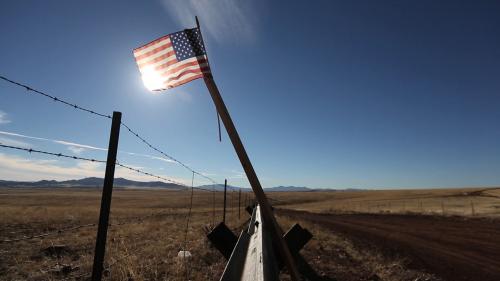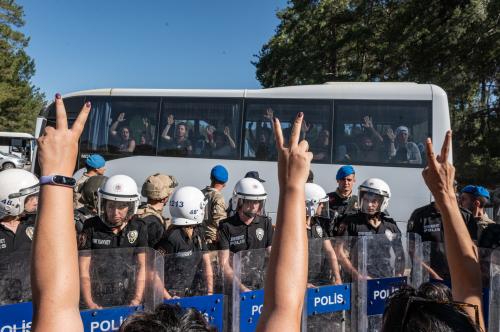Thousands of migrants are heading north through Mexico toward the U.S. border. The number of Border Patrol encounters with migrants and asylum seekers at the U.S.-Mexico border continues to be high. And for two years in a row, the number of illegal crossings has exceeded 2 million. Meanwhile, border security remains a hot political issue as Republicans in Congress and on the campaign trail accuse President Biden of having an “open border policy.” Vanda Felbab-Brown, a senior fellow in Foreign Policy at Brookings offers insight about what’s happening on the border.
Transcript
[music]
DEWS: You’re listening to The Current, produced by the Brookings Podcast Network. I’m your host, Fred Dews.
News reports say a new group of thousands of migrants is heading north through Mexico toward the U.S. border. The number of Border Patrol encounters with migrants at the U.S.-Mexico border continues to be high. And for two years in a row, the number of illegal crossings has exceeded 2 million. Meanwhile, the issue of border security has become a hot political issue as Republicans in Congress and on the campaign trail accuse President Biden of having a quote, “open border policy.”
To help us understand what’s going on and some of the policy dimensions, I’m joined by Brookings expert Vanda Felbab-Brown, a senior fellow in the Strobe Talbott Center for Security, Strategy, and Technology in Foreign Policy at Brookings, and she also directs the Initiative on Non-state Armed Actors.
Before the interview, I want to tell you about another podcast you might like. Every week on Foreign Policy Live, host and FP editor-in-chief Ravi Agrawal sits down with world leaders and policy experts on the issues that matter most to you. People like U.S. climate envoy John Kerry, economist Larry Summers, and Ukraine’s deputy foreign minister, Emine Dzhaporova. Whether it’s the U.S.-China relationship, the war in Ukraine, or the Global South’s growing clout, Foreign Policy Live is your weekly fix for smart thinking about the world. Listen and follow wherever you get your podcasts.
Vanda, welcome to The Current.
FELBAB-BROWN: Thank you.
DEWS: So, let’s start with one big question, Vanda. As I mentioned in the intro, President Biden’s Republican opponents say he and Democrats support a quote “open border policy.” What do you make of that claim?
FELBAB-BROWN: Well, it’s not true. Now certainly it’s not true about the Biden administration, but more broadly it’s not true about various democratic administration. Let’s remember that President Barack Obama was nicknamed as the “deporter-in-chief.”
And the Biden administration from the beginning, in many ways, perpetuated many of the border policy that were started during the Trump administration. There were some very important differences, certainly from their families, from their parents, were suspended and were countered.
But some of the crucial policies like keeping people in Mexico while they were awaiting their asylum cases in the U.S. were very much embraced by the current administration, by the Biden administration.
And at the same time, the Biden administration has really put a lot of money into trying to strengthen controls in legal ports of entry, which is the place where most drugs and most fentanyl are smuggled into the United States. And it is often the Republican side of the House that has been preventing budgets to go into these enhanced ports of entry measures.
So, beating up the Biden administration on migration is a popular political ploy of many Republican politicians. A nd certainly we have very high numbers of people trying to cross, but it’s not because the Biden administration policies have been really lenient, let alone an open border.
DEWS: I do want to get to the causes of the migration first, but to stick on this question of the Biden administration and policy, the administration recently announced it would waive a number of laws to build about 17 or 20 miles of border wall in southern Texas, a reversal of one of Joe Biden’s campaign pledges to not build quote, “another foot of wall,” unquote. So, what’s happening there?
FELBAB-BROWN: Right. So, I think that what’s happening with these 17 miles is both part of the legacy and inheritance as well as the politics. As you said, Fred, a core premise and promise of the Biden administration was that the wall is not effective and will not be continued.
And indeed, the Biden administration essentially suspended building the wall, although it never went to tear down the pieces of the wall that were constructed during the Trump administration. Even those long-fingered bollard posts were breached by people in various ways, by both drug traffickers as well as human smugglers. But nonetheless, the Biden administration kept the existing constructions more or less without really taking it apart, but it said it would not be building more stuff. Now this is now being contradicted, or seemingly contradicted, by the fact that they announced they would build these 17 miles and they would waive laws to do it.
Now, the Biden administration officials are saying, look, we are really not reversing our pledges. This is what we are legally mandated to do by Congress. Congress appropriated the money and we have tried to have the money re-appropriated to some other tools of border control, not been willing to work with us, they have not been willing to re-appropriate the money, we have to spend the money on the wall, the only way we can legally comply with the requirement of spending the money on the wall is to waive the 20 laws that would prohibit us from doing so. So, they’re saying we don’t want to do this, but we are pushed.
But of course, for supporters of the Biden administration, this looks like going back on the promise.
DEWS: I want to let listeners know that a few years ago, you wrote and published a Brookings essay that I had the pleasure of editing called The Wall. And it went through a lot of the issues around an actual physical barrier.
Vanda, why are so many people on the move through Mexico, from parts south of Mexico?
FELBAB-BROWN: Well, for years we have had a series of root causes that are driving people to move that have not been addressed. And this is true in the Americas certainly, but it’s also part of a global phenomenon. Because of persisting poverty, inability of local government structures and entities to provide for the economic aspirations of people and for their safety, people are moving.
In the Latin American space, there is tremendous insecurity due to highly violent organized crime that takes different shapes. The maras and pandillas in Central America are different type of criminality than that encountered in Venezuela or Colombia. But nonetheless even countries that have previously appeared to be doing better in terms of public safety measures, like Ecuador or Chile, are experiencing different intensities of public security crisis.
So you have these big public security challenges, highly violent crime and organized crime, you have persisting economic social challenges, and that is all now compounded also by environmental stress, such as global warming, but it’s hardly the sole factor. So, in a sense, people are not being able to live safely and reasonably economically well in their home places.
And sometimes the insecurity can be intense, the pressure that families face in Central America from the , from the gangs that are trying to recruit their children to live very brutal lives and be part of murders and other repression, children as young as 12, are enormous and they’re driving families to move.
But on top of that, what is also happening now is the Americas have become a conduit for people coming from across the oceans. So we are having people from Africa that are now coming up through the Americas to try to get to the United States or Canada.
So the patterns are staying less regional on top of that.
And the Biden administration and the Obama administration, unlike the Trump administration, have tried to focus on addressing the root causes. When Biden was the vice president of very essential American initiatives that were seeking to generate the economic growth, job growth, and safety in Central America so that people didn’t have to move.
And when he became president, he tried to reinstate a lot of these efforts, perhaps under different names, but the same idea was there: address the root causes so that people would not be compelled to move—policies that were completely suspended and defunded during the Trump administration, that there were none of these policies.
But it’s become obvious, just as it was during the Barack Obama administration, that addressing the root causes is a long, difficult, sometimes tortured process, that it’s not something that happens in two or three years, which doesn’t mean that they should be defunded, but the results are far more delayed. The positive results, the hopeful results, are far more delayed and people are moving. So we’re seeing these enormous numbers on the southern border.
DEWS: So, what is Mexico’s official policy on migrants coming through its territory? I mean, thousands of people are moving all the way through Central America, then through Mexico, through border towns in Mexico, all the way north through Mexico. What is the Mexican government’s approach and policy to migrants in its territory?
FELBAB-BROWN: You’re absolutely right, people are coming from the southern cone, they are coming through the Darien gap and then head through Central America to Mexico and try to get to the U.S.
So, Mexico has learned or did learn during the Trump administration that it can exercise enormous leverage over the United States and over issues of interest in the very multifaceted U.S.-Mexico bilateral relationship by turning off and on the spigot of migration. And this has really been highly detrimental to a whole set of U.S. interests and frankly it’s been also highly detrimental to the health of democracy in Mexico.
Let me explain that. So, right now Mexico is putting significant amount of resources at its southern border with Guatemala, with Belize, so people are not coming through that border. The border is long, complicated, it’s jungles, it’s rivers, with even many assets concentrated there, people still get across. And then they end up in Mexico, where they will try to make their way north, sometimes on their own, working with individual coyotes, sometimes organize groups play a role in the movement of people.
And Mexico then has more assets at the northern border to try to keep people from coming into the U.S. Now for that, Mexico is extracting from the U.S. all kinds of payments, not monetary payments, but payments in terms of policies. Such as, for example, Mexico has been really an inadequate partner during the administration of Andres Manuel Lopez Obrador on countering criminal groups in Mexico and countering the flows of fentanyl to the United States.
And it’s making this trade-off. Okay, you want to push us on cartels on fentanyl? Well, guess what? We will let the migrants flow and because of U.S. internal domestic politics, the migration issue is just so high on the agenda that the Trump administration constantly gave up on any other interest in order for Mexico to control the flows and the Biden administration has found itself in much of the same straight jacket.
There’s one other element that I need to emphasize here. The Trump administration negotiated a deal with Mexico, where people would be very quickly deported out of the United States into Mexico, and then their asylum cases would be adjudicated while they waited in Mexico. And the Biden administration renewed that. First, it renewed it under authorities related to COVID. When COVID was no longer a national emergency. It found other ways to make that same deal repeat.
So, Mexico is not just stopping flows of people or not, but frequently stopping them, but it’s also hosting people that are applying for asylum while they are waiting for their asylum case. And this could be years while their case is being adjudicated.
DEWS: Yeah, I think it’s worth following up on that question of asylum because a large majority of these people are trying to apply for asylum to the United States because they’re fleeing whatever conditions at home. Can you talk a little bit more about kind of asylum seekers versus what people call illegal immigration?
FELBAB-BROWN: Well, unfortunately, people kind of get treated with this same brush and there is very little empathy for the horrendous conditions that people are escaping from.
The lack of empathy is both a function of the way that people are talked about, the politics, the narratives around it. There certainly needs to be recognition that many of the migrants who are coming in these large numbers can cause significant strain on local services. I mean, we know from consistent evidence, repeated consistent evidence, that working age migrants bring a lot of economic benefits to countries. To countries where especially there is not significant unemployment—in the United States, there is virtually no unemployment—but there are very many jobs that U.S. citizens don’t want to work.
Those also have a highly aging population. So economically, migrants bring a lot of economic dynamism, they bring jobs, they bring services, and they bring … they fill jobs that are not being filled. But nonetheless, while there are these vast economic benefits overall, you also have highly concentrated costs for particular localities.
And so there is often very little willingness to kind of distinguish or treat asylum seekers differently.
The other reality is that many people who are applying for asylum find it actually extraordinarily hard to get asylum. So the U.S. asylum system is very much geared towards specific categories of people. People prosecuted religiously or people who were prosecuted in China, people who were prosecuted by communist regimes are far more likely to get asylum than people who are escaping extraordinarily brutal criminal groups. And even if the criminal groups create conditions that are essentially like a war, like a civil war, nonetheless in the legal U.S. asylum system, those facing criminal groups instead of violent insurgents or communist regimes are much less likely to be granted an asylum. So, many of the people might be in horrendous conditions and they still will face ultimately a very, very high chance that they will not be granted an asylum.
DEWS: So, Vanda, as you look at what’s happening on the U.S.-Mexico border, what do you think is the most critical issue there, if there’s only one? Is it the asylum seekers themselves or the asylum process? Is it the sheer volume of migrants? Is it the drugs or weapons that are coming across the border?
FELBAB-BROWN: Well, it’s all of the above. Right? So, we have known in the United States for some decades, three decades at minimum or longer really, that the US immigration system is broken. There are both inadequate laws that there are not enough legal pathways for temporarily legal employment. If we have people who could come and work legally and go home to their families, that often generates far more people moving both ways and reduces some of the pressure on services.
Getting to effective reform of the U.S. immigration system has been an objective of multiple administration going back to George W. Bush. He had wanted to do that, and Texas governor with credentials of being tough on the border security. Here was a moment when there was an opportunity or it was thought, migration reform, immigration reform will happen. Didn’t.
So, we have these dysfunctional broken immigration laws that make it very difficult to allow people to come and work legally, even when they need, even when businesses and services need jobs. You can go as far as North Dakota right now, very, very northern states, that are acutely suffering a lack of nurses, for example. And many of these localities very keen to attract people, and we are seeing them reaching out to bring asylum seekers, asylum seekers from Ukraine for example, asylum seekers from other countries, but it’s locality specific and it’s not yet part of our overall policy.
The numbers are very high and the numbers of migrants crossing the border are very high and they are really straining capacities of everyone, whether it’s local services, whether it’s the border patrol, the conditions in which migrants are staying we have seen over the past two, three years some really horrific images of conditions where people were crammed into shelters, not having access to beds, not having access to basic toilets because the volume is so high.
And we are now seeing strain even up north with some of the major Democratic states like New York, where migrants are being directed either by states, most of the time by the border states. They are struggling with the numbers. So, the number issue is certainly a big one.
And the border is a major conduit of drugs, of fentanyl. Fentanyl is a massive public health crisis. It’s killing 300 Americans a day, and 110,000 people overdosed last year. The numbers could be, actually overdosed and died last year. The number of people who overdosed was several times higher, but people survived.
Now, the fact that you survive an overdose does not mean you’re fine. People can have long, even lifelong, debilitating consequences of what the overdose did to them. But we are having this massive public health crisis in terms of fentanyl, and most of fentanyl is coming through legal ports of entry. So, this is where the Biden administration has tried to strengthen inspection, which is badly needed, and the Republican side of the Congress has been blocking that money.
Let me just focus a little bit on that. So, the border is of course not just a barrier, it’s a membrane, it’s a place where some flows are to be kept out and other flows are to be allowed, are to be facilitated. The legal movement of people, the legal movement of cargo. Mexico is a vital trading partner in the era of deglobalization, of moving away from offshoring to nearshoring. There is desire and imagination that we will have even far greater flows of legal goods across the border with Mexico, across the border with Canada.
Yet as it currently stands, only about 2% of personal vehicles are being inspected and only 14% of trailer trucks. Those are very, very low numbers. And for something like fentanyl, you need few trailer trucks, not full, to hide your fentanyl in legal cargo and you can supply the U.S. market for a long time and kill very many people.
So, pushing the inspection numbers higher is imperative. It requires one of two things. Either there have to be more non-intrusive technologies or one needs to be willing to manually inspect more. The intrusive manual inspections take tremendous amount of time and they have vast economic consequences. So, there is pushback because cargo is rotting, because businesses want the chips, the auto parts.
So, the Biden administration has proposed technologies that would increase significantly non-intrusive inspections that would allow up to 70% of trailer trucks to be inspected and move the 2% of personal vehicles to 40. This is something that was adopted as a policy in the spring. The implementation is taking time, including because again, this budgetary issue with the Congress, the Republican side of the Congress being reluctant to appropriate money comes into that place.
One often hears the rhetoric from various republican politicians that it is migrants that are bringing fentanyl in. That is simply not the case. The numbers are not there. Over 90% of fentanyl or late 80s is brought in by U.S. citizens with U.S. cars. Yes, they’re working for the cartels, but it’s not migrants. Migrants who are personally crossing the deserts and trying to wade over or swim over the river are not bringing fentanyl.
DEWS: They’re mostly trying to come to the United States for a better life for themselves and for their families.
FELBAB-BROWN: Right.
DEWS: So, Vanda, the policy implications are vast. We could have a whole podcast series just on that alone, but this context you provided is invaluable for our understanding moving forward. So I thank you for your time and your expertise today.
FELBAB-BROWN: Thank you very much Fred for having me.






Commentary
PodcastThe US-Mexico border challenge
November 9, 2023